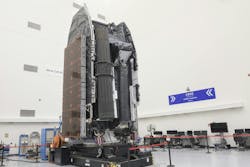Questions and Answers:
Q: What is the ViaSat-3 F2 satellite? A: ViaSat-3 F2 is the second spacecraft in Viasat Inc.’s next-generation, high-capacity GEO satellite constellation, designed to deliver broadband connectivity across Europe, the Middle East, and Africa.
Q: What is the capacity and capability of the ViaSat-3 satellites? A: Each ViaSat-3 satellite provides at least 1 terabit per second of throughput, features dynamic beam-forming and frequency agility, and can serve users on land, at sea, and in the air. The full three-satellite constellation offers roughly 3 Tbps of global capacity.
Q: What markets or applications will ViaSat-3 F2 support? A: The satellite is intended for global broadband access, supporting commercial mobility, government and defense communications, in-flight and maritime connectivity, and underserved or remote regions.
EL SEGUNDO, Calif. - Boeing in Arlington County, Va., has delivered ViaSat-3 F2, the second spacecraft in Viasat Inc.’s next-generation ultra-high-capacity constellation. Built on the Boeing 702MP+ platform optimized for high power and all-electric propulsion, the satellite was integrated with Viasat’s payload at Boeing’s El Segundo facility and is set for launch in the second half of October aboard a United Launch Alliance Atlas rocket.
"Our goal is to enable missions with reliability and timely delivery," said Michelle Parker, vice president of Boeing Space Mission Systems. "With ViaSat-3 F2, we leveraged proven 702 heritage, advanced power systems, and all-electric propulsion to enable high-speed connectivity for users who rely on it."
The satellite is the second of three ViaSat-3 spacecraft, designed to expand Viasat’s flexible global broadband network for users on land, at sea, and in the air. Each satellite adds roughly 1 terabit per second of capacity through a highly adaptable payload developed by Viasat Inc. in Carlsbad, Calif.
The Boeing 702MP+ bus features all-electric propulsion, enhanced structural support for high-power payloads, and next-generation solar arrays from Boeing subsidiary Spectrolab. Boeing and Viasat teams will jointly support launch operations in Florida as part of their ongoing collaboration on satellite programs.
Constellation overview
The ViaSat-3 constellation comprises three geostationary Ka-band satellites, providing global coverage: one over the Americas, one over Europe, the Middle East, and Africa, and a third planned for the Asia-Pacific region. The first satellite was launched in 2023 and entered service in 2024. ViaSat-3 F2, which will cover EMEA, is scheduled to launch in October 2025, followed by the Asia-Pacific satellite in 2026.
Each ViaSat-3 satellite delivers at least 1 terabit per second of throughput, offering a combined constellation capacity of about 3 Tbps. The satellites provide more than 25 kilowatts of power to their payloads and weigh roughly 6 metric tons each. ViaSat-3 employs dynamic beam-forming and frequency agility, enabling the network to shift bandwidth where demand is highest across air, sea, and land users. The constellation’s large solar arrays and steerable reflectors enhance both power generation and signal coverage, supporting an operational life of more than 15 years.
About the Author
Jamie Whitney
Senior Editor
Jamie Whitney joined the staff of Military & Aerospace Electronics in 2018 and oversees editorial content and produces news and features for Military & Aerospace Electronics, attends industry events, produces Webcasts, and oversees print production of Military & Aerospace Electronics.
